The Carbon Cycle – Nature or Nurture?
By Ed Caryl
We know, from ice measurements, measurements at Mauna Loa, Hawaii, Barrow Alaska, and the South Pole, that atmospheric carbon dioxide has been increasing in our atmosphere since the beginning of the industrial age. We also know that temperatures have been increasing in that same time interval, as the earth warms up from the “Little Ice Age.” The proponents of the theory that man’s production of CO2 has resulted in this temperature increase, use that idea to predict future temperature increases based on our continuing to use fossil fuels and continuing to force an increase in atmospheric CO2. But, is the increase in CO2 due to man; or is the increase in CO2 natural, due to rising temperatures caused by natural means?
The natural CO2 flux to and from oceans and land plants amounts to approximately 210 gigatons of carbon annually. Man currently causes about 8 gigatons of carbon to be injected into the atmosphere, about 4% of the natural annual flux. There are estimates that about half of man’s emissions are taken up by nature. But is that true? Are there variations in the natural flux? Could those explain the CO2 increase?
Figure 1: From NOAA and the IPCC, here.
In June, 2011, Dr. Murry Salby gave a presentation at a IUGG meeting in Melbourne, Australia. This presentation was mentioned later on Judith Curry’s blog, and some others. DirkH brought this presentation to my attention recently in comments on NTZ, and I tracked down the YouTube version. In that presentation, Dr. Salby plotted the changes in CO2 and changes in global temperature and soil moisture. The soil moisture data is behind a paywall, but the monthly global temperature and sea surface temperature sets are easily and freely available from WoodForTrees. The annual carbon fossil carbon release figures are also available, covering nearly the same period as the Mauna Loa CO2 numbers.
The differential changes in CO2 are calculated on a two-year centered average of the monthly figures, then taking the monthly differential on that average. This gives a somewhat smoothed number, removing the annual cycles, yet preserving the timing.
Figure 2: Monthly change in CO2 at three measuring stations.
Figure 3: Magnified view of Figure 2.
Figure 3 is a magnified view of Figure 2, the interval from 1990 to 2000, showing the effect of the Mt. Pinatubo eruption in June 1992 and the El Niños of 1995 and 1998. The sharp cooling from the volcanic eruption appears before June 1992 because of the centered averaging to remove the noise and the annual variation.
Changes in CO2 seem muted at the South Pole, and the Barrow station is noisy as well as having a somewhat short record. Effects at the equator appear delayed at the stations closer to the poles. For those reasons, we will use the Mauna Loa record. It seems evident from Figures 2 and 3 that temperature influences CO2. But is it the global land and ocean temperature, or just the sea-surface temperature that is most important? Figure 4 is a plot of global surface temperature and monthly CO2 change:
Figure 4: Global surface temperature and monthly CO2 change.
The plots in Figure 4 look very similar; the question is how similar?
Here is the scatter diagram:
Figure 5: Scatter diagram of the data in Figure 4. Note the R2 value is 0.47636.
Here is the same comparison using sea surface temperature (HADSST2).
Figure 6: Plot of the monthly sea surface anomaly and monthly CO2 change.
Figure 7: Corresponding scatter plot showing an R2 value of 0.5528.
Sea surface temperature seems to be driving atmospheric CO2 changes. This makes sense because CO2 solubility in seawater is temperature dependent.
But what of man’s CO2 additions to the atmosphere? The data for carbon release is annual data, so the graphs are much coarser in appearance, and the change in CO2 must be annualized.
Figure 8: Annual change in fossil carbon use and the annual change in CO2.
Figure 9: Scatter diagram of carbon emissions change vs atmospheric CO2 change. Note that the R2 value is 0.05386, less than a tenth of the value of SST vs CO2.
It is ten times as likely that atmospheric CO2 is coming from natural sources, namely the warming ocean surface, as it is likely that it is coming from anthropogenic sources. The changes in CO2 track ocean surface temperature, not global carbon emissions. Burning fossil fuels is not increasing atmospheric CO2. Recovery from the Little Ice Age, driven by the sun, is causing the oceans to release CO2. It is temperature driving CO2 release, not the other way around. Just as it has always been.
As the sun gets quiet in the next few years, sea surface temperature will begin to fall, and the rise in CO2 will cease. If the sun stays quiet for 30 or 40 years, ocean surface temperatures will fall far enough to reverse the CO2 rise, the globe will enter a new little ice age, and things will get really interesting.
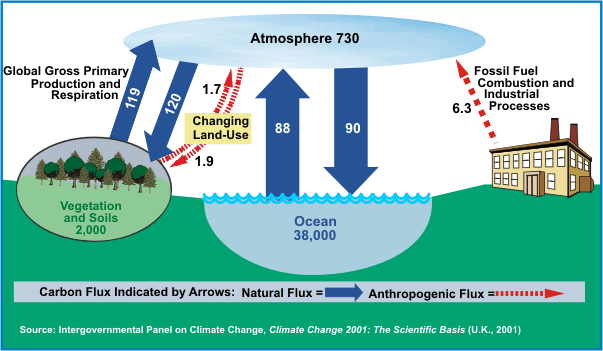
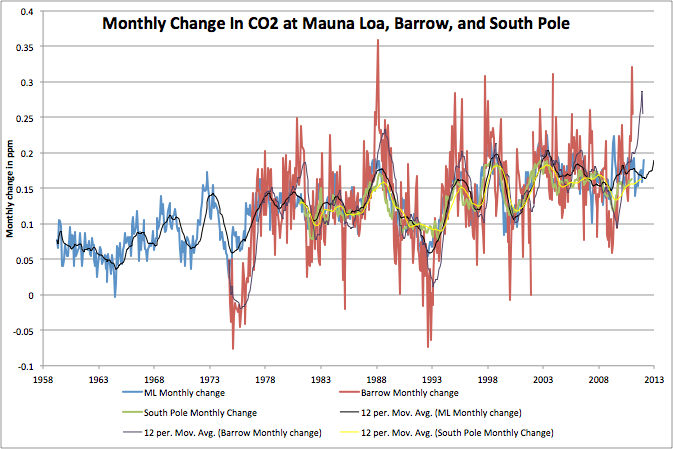
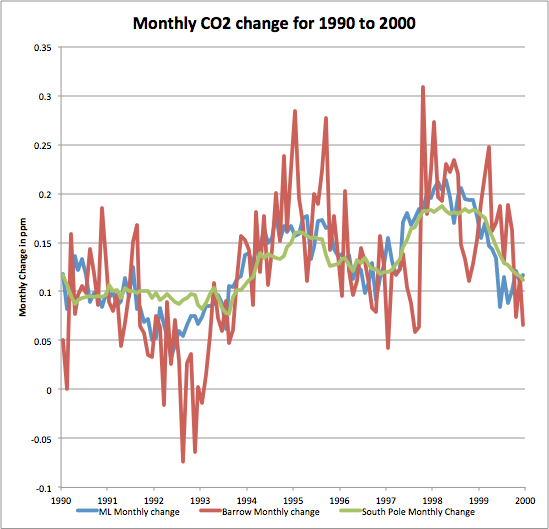
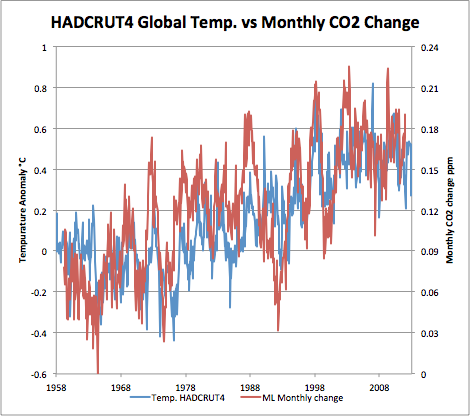
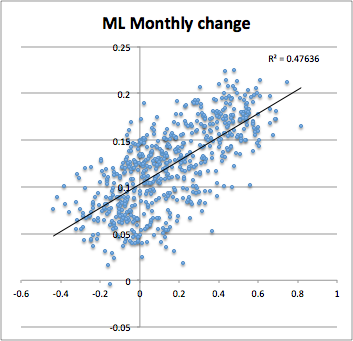
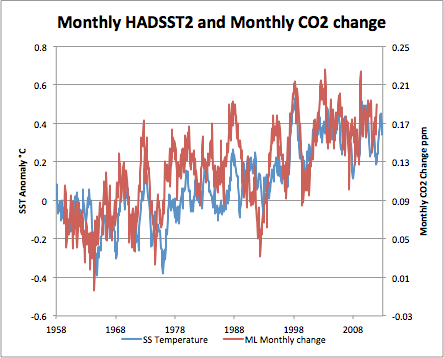
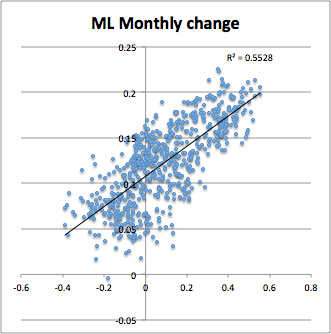

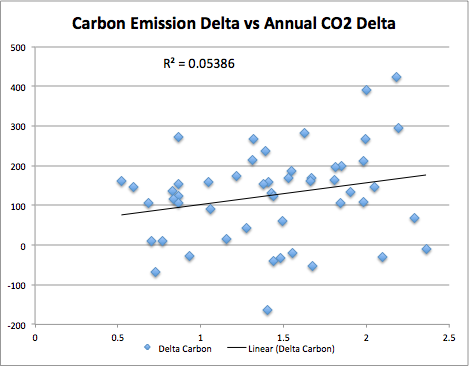





“It is ten times as likely that atmospheric CO2 is coming from natural sources.”
Bold statement, Ed. It’ll be intersting to see what other readers think. It’ll be quite spectacular should the CO2 stop rising. I don’t believe it did during the cooling of 1945 to 1980.
It went negative at Barrow in 1975 for a year.
“As the sun gets quiet in the next few years, sea surface temperature will begin to fall, and the rise in CO2 will cease.” Is that a prediction, Ed?
Doesn’t it sound better than “we will all burn/drown/starve/(pick your preferred disaster)?” Yes, that’s a prediction.
It does sound based in reality and dependent upon empirical measurements and observations, yes. However, as I understand it we don’t know the balance between natural and man-made CO2, only that the rise is composed of both, and I agree that the natural component is probably the largest by some measure. Is it not possible that the natural component could stabilise/fall, but the man-made component would increase, giving an overall rise, so your prediction would be right in principle but wrong on detail?
I think it is possible to figure out the proportion of natural variation to man-made. That is my next project.
Good luck with that, such a discovery would materially affect the science.
Ferdinand Engelbeen and Luboš Motl have written about CO2 but I have not saved the links.
You may wish to watch a more recent presentation by Dr. Murray Salby, on the gobal energy budget and man-made CO2, dated 2012 07 24: http://www.youtube.com/watch?feature=player_embedded&list=PLILd8YzszWVTp8s1bx2KTNHXCzp8YQR1z&v=ZVCps_SwD5w
The whole presentation is very interesting, but a highlight that is of interest to this discussion thread begins at 32:30 into the video. Murray Salby stated something like this: “These large net-changes in CO2 emissions [which vary annually from 0% to almost 200%] are uncorrelated with human contributions [4% of annual emissions, with 96% coming from natural sources], which increase only gradually.” (At 34:40 in the video)
Murray Salby makes an important clonclusion, namely that CO2 variations, although unrelated to human emissions, are correlated to the *integral* of global temperature changes (r^2 = 0.93).
To my knowledge, Murray Salby’s paper on this is still waiting for publication. Will we get to see it? (I guess, not if some of the hockey-stick team have their way and manage to “redefine what peer-review is.”)
The Dr. Murry Salby lecture was very interesting but I had to listen to it 5 times before I understood it. Some sections at key points I replayed over and over before I got it.
The correlation between the land temperatures and the derivative of the Mauna Loa was I thought, the most obvious conclusion, not the sea.
The other point I figured out at the time was the importance of the C13 component which was the sure sign of AGW, but turned out to be natural too.
It is good to see this article, but I would have enjoyed it more if it presented Dr. Murry Salby’s conclusions in an easier way than Salby did, and included all the aspects of the issue that he raised.
Ed Carlyle stated: “It is ten times as likely that atmospheric CO2 is coming from natural sources,…”
Is that perhaps a bit low? Murray Salby, using figures from the IPPC, puts the ratio at 24 : 1 (96% from natural sources vs. 4% man-made). He also stated that annual variations in CO2 emissions from all sources (of which the human emissions are small but increase steadily) vary from 0% to almost 200%. (Link to YouTube video: http://www.youtube.com/watch?feature=player_embedded&list=PLILd8YzszWVTp8s1bx2KTNHXCzp8YQR1z&v=ZVCps_SwD5w )
Walter, I’m working on Part 2 now. I should have said “at least ten times as likely…” So far, my numbers agree with Salby, and he may have been high.
I have a brilliant idea. Measure the isotopes in the carbon dioxide. If over the years the percentages of Carbon-13 and Carbon-14 are dropping, that means that carbon dioxide entering the system comes from burning fossil fuels.
Oh? They’ve done that? And they found that most of the carbon dioxide increase comes from fossil fuels? Well I never.
The alarmists are always on the lookout for basic errors like this to make skeptics look like a bunch of ignorant rednecks, so I suggest that this post either gets taken down or modified, very quickly.
http://en.wikipedia.org/wiki/Carbon-14
Fascinating article Ed. Thanks for your effort. Makes good sense, which means the consensus will have no interest in it whatsoever.
Below is an interesting article, it look at mans CO2 contribution from a different angle.
http://www.ilovemycarbondioxide.com/pdf/Carbon_Dioxide_The_Houdini_of_Gases.pdf
and here is Roy Spencer’s take on the isotope issue.
He writes, “And as shown in the next figure, the CO2 changes tend to follow the temperature changes, by an average of 9 months.”
http://www.drroyspencer.com/2009/01/increasing-atmospheric-co2-manmade%E2%80%A6or-natural/
Salby’s paper was purportedly “in press” when his talk was recoded in 2011. Anyone know if it was ever published?
well, it is a nice work, but it only shows clearly that when temperature rises ,CO2 rises…amazing this is true for many time scales.
OK
Then, what about the cause of global warning….what part of this warming is due to CO2…just like before if it a matter of faith in model.
And this effetc can act like an amplification for modelist.
But nice job. Good correlation. Quite rare in this issue.
@Mike Mellor
You should listen to the presentation before spouting off. Arrogance and sarcasm will get you everywhere but it won’t educate you.
Here you go:
http://climaterealists.com/index.php?id=9508
“Evidence that Oceans not Man control CO2 emissions “
[…] add more confusion to the role of carbon dioxide from burning fossil fuels, a paper by Ed Caryl “Most Of The Rise In CO-2 Likelly Comes From Natural Sources.” This paper examines […]
All of those graphs that explain a rise in CO2 emissions are not her graphs. This Dr. Murray Salby is plagiarizing & falsifying a lot scientists that made those graphs. Those graphs were originally created by other scientists who use those graphs to prove CO2 emissions are man made, not natural. I know this because I have seen every one of these graphs in my astronomy class on my Professor’s presentation slide and he has credited all of those graphs to other scientists; of which not a single one was Dr Murray Salby. Yes, nature can cause global warming, but only in the course of millions of years because nature overall only produces approximately 0.4-0.6% of CO2 gases in a year, whereas the CO2 emissions are more than 3-4% every year around the world from industrial plants. China is a superb example that the rise in CO2 emissions is man-made. The Great Wall of China used to be seen from the Forbidden City in Beijing, but now because of all the smog in China, the Great Wall of China can not be seen at all. Global Warming is a very real event due to the human race. The facts point to us being responsible for global warming. Those graphs above have been misused by Dr Murray Salby and he/she must be discredited immediately. (Not because she’s wrong, but because she is plagiarizing & falsifying the above graphs.) When hurricanes, volacanoes, tsunamis, and other major natural disasters occur the CO2 emissions rise to a mere 0.7-1.2%. The 1883 Krakatoa eruption had produced approximately a whopping 200 tonnes of CO2, however that what was one small area with its ONLY MAJOR eruption. Krakatoa’s other eruptions as come nowhere near that amount of CO2. Mount St Helen’s eruption was nowhere near Krakatoa’s 200 tonnes of CO2. So if Krakatoa can NOT cause worldwide global warming, then no part of nature can in such a short amount of time frame. Educate yourselves to the truth, not the lies. Question people, don’t just take their word for it. Do your own research and educate yourselves to be able to sift through the lies and uncover the golden truth!
Yawn…zzz
If Nick had actually watched one of Salby’s presentations, he would know that Dr. Murray Salby is a man.
I’m pretty sure a lot of the numbers are completely wrong here as well. Mankind produces 24 gigatons of CO2 annual per the US Geological Survey for starters, and then you have misleading info like how the oceans store 38,000 gigatons of emittable carbon, and the worlds vegetation contain 2000, etc. Yes, almost all of which is stored indefinitely there, thank god.
That this batshite “paper” is one of the highest Google searches for multiple searches relating to CO2 emmissions is asinine.
Follow the link. Those are NOAA numbers.
This analysis dabbles in tiny minutae of the data while ignoring substantial data that is practically shouting at 120 decibels.
The substantial data of course is that the rate of change of CO2 in the air suddenly and dramatically changed precisely at the time when the industrial revolution began.
This analysis speaks of odds of ten to one. The odds that such a sudden, gigantic shift in the CO2 rate of change just happening to coincide exactly with the advent of the industrial revolution are thousands and thousands to one. Bayesian probability analysis says human emissions are the cause of CO2 rise by a thousands to one margin.
Mark, do you have a link to the Mauna Loa CO2 data from before the industrial revolution? TIA.
Mark wrote:
This analysis speaks of odds of ten to one. The odds that such a sudden, gigantic shift in the CO2 rate of change just happening to coincide exactly with the advent of the industrial revolution are thousands and thousands to one. Bayesian probability analysis says human emissions are the cause of CO2 rise by a thousands to one margin.
________________
The Keeling Curve shows an annual change in carbon dioxide of 1.346 parts per million PER YEAR. Only 4% of this is anthropogenic.
So you contend that an increase in 1 part per million of carbon dioxide, in 22 years, on a base of ~26,000 parts per million of atmospheric greenhouse gases is DRIVING EARTH’S CLIMATE!!!
Do a Bayesian probability analysis on 1/26,000 every 22 years, please.
The global warming fraud is being perpetuated by *scientists* bent on extracting all the grant monies they can as quickly as they can. This is ostensibly to *prove* something you all claim is already established fact.
The rise is also coincident with the end of the Little Ice Age and the associated natural rise in temperature.
More recent Salby release:
https://www.youtube.com/watch?v=Li75zFoaKlI
Figure 8 shows change in atmospheric concentration and change in emission of CO2. Because these are uncorrelated, that is supposed to constitute evidence against the idea that human CO2 emissions drive increase in atmospheric concentration.
However, the equation for any concentration is d/dt C = aF, that is, the change in concentration C is proportional to the flux F of stuff in/out of the volume you are considering. That is, if you put 1 Gton of something into the atmosphere every year C will change by the same amount every year. But this graph is testing d/dt C = a d/dt F. It is saying that if you put 1 Gton in every year, the change in F will be 0 and d/dt C will be uncorrelated with d/dt F. So the graph seems to be testing the wrong thing.
Skeptical Science has a good discussion of other problems with Salby’s idea. http://www.skepticalscience.com/Murry-Salby-CO2-rise-natural.htm